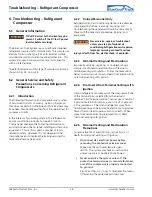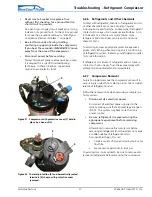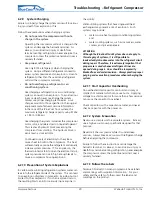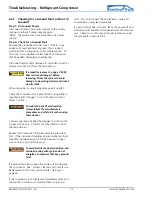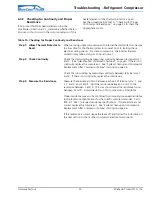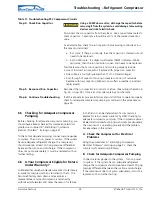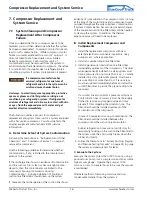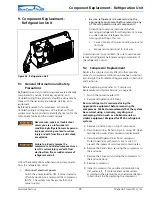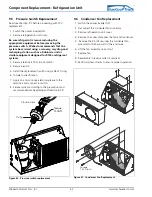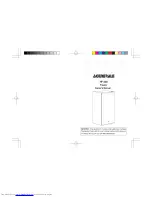
Troubleshooting – Refrigerant Compressor
www.webasto.us
27
Webasto Product N.A., Inc.
™
•
Never reset a breaker or replace a fuse
without first checking for a ground fault (a
short circuit to ground).
An open fuse or tripped circuit breaker is a strong
indication of a ground fault. To check for a ground
fault, use the procedure outlined in “Identifying
Compressor Electrical Problems” on page 31.
•
Be alert for sounds of arcing (sizzling,
sputtering or popping) inside the compressor.
If you hear these sounds, IMMEDIATELY move
away from the area of the compressor.
•
Disconnect power before servicing.
Always disconnect power before servicing, unless
it is required for a specific troubleshooting
technique. In these situations, use extreme
caution to avoid electric shock.
Figure 31. Compressor with protective cover (1) held in
place by a hex-nut (2)
Figure 32. Thermal protection (3) and hermetically sealed
terminals (4) shown with protective cover
removed.
6.2.6
Refrigerants and Other Chemicals
Contact with refrigerant, mixtures of refrigerant and oil,
or other chemicals can cause a variety of injuries
including burns and frostbite. For example, if refrigerant
contacts skin or eyes it can cause severe frostbite. Also,
in the event of a compressor motor failure, some
refrigerant and oil mixtures can be acidic and cause
chemical burns.
To avoid injury, wear appropriate protective eye wear,
gloves, and clothing when servicing an air conditioning
or refrigeration system. Refer to your refrigerant supplier
for more information.
If refrigerant or mixtures of refrigerant and oil come in
contact with skin or eyes, flush the exposed area with
water and get medical attention immediately.
6.2.7
Compressor Removal
Failure to properly remove the compressor can result in
serious injury or death from electrocution, fire or sudden
release of refrigerant and oil.
Follow these precautions when removing a compressor
from a system:
•
Disconnect ALL electrical power.
Disconnect all electrical power supplies to the
system, making sure that all power legs are open.
(NOTE: The system may have more than one
power supply.)
•
Be sure refrigerant is recovered using the
appropriate equipment before removing
compressor.
Attempting to remove the compressor before
removing all refrigerant from the system can cause
a sudden release of refrigerant and oil.
Among other things, this can:
•
Cause a variety of injuries including burns and
frost bite.
•
Expose service personnel to toxic gas.
To avoid serious injury or death, be sure to remove and
recover all refrigerant before removing the compressor.
2
1
4
3














